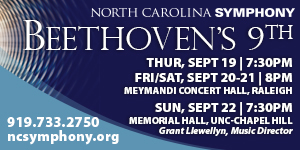The Flat Rock Playhouse Downtown at 125 S. Main Street in Hendersonville is a very congenial venue in which to hear music. Seating wraps three quarters of the way around the intimate performance space which has excellent acoustics. The two performers ‒ pianist Christopher Tavernier and clarinetist Matthew Hanna ‒ explored music of the nineteenth and twentieth centuries with a “French Connection.” The event was sponsored by Agudas Israel Congregation to benefit the Henderson County Hunger Coalition. Dr. Joann Freeburg, Founder and CEO of the Music Foundation of Western North Carolina, greeted the audience in perfect French before changing to English.
I’ve been reading about Tavernier for some time. A 17-year-old artist who has been carefully taught by Dr. John Cobb, the young man has garnered many impressive competition wins and plays an astonishing array of the really big solo and chamber music literature. According to his teacher, he plans to pursue a career as a concert pianist. From what I heard in this performance, he is well on his way to realizing that big dream.
Matthew Hanna, a student of Dr. Robert Chesebro at Furman University, is a seasoned performer who placed first in the International Clarinet Association 1995 Young Artist Competition, and since then he has performed with many orchestras in our area. In addition to his performance activities, he manages his own recording studio.
The program began with the Sonata for clarinet and piano, Op. 184, by Francis Poulenc (1899-1963). This piece, his last completed work, was written for Benny Goodman and dedicated to Arthur Honegger. Goodman and Leonard Bernstein debuted the work at Carnegie Hall in 1963. Poulenc’s style was antithetical to the lush impressionism of Debussy. Identifying with other like-minded composers who became known as Les Six; he wrote in a direct style of “simplicity, clarity, freedom, and wit.” The opening Allegro tristement – Allegretto embodied Poulenc’s style with short melodies, whimsical leaps and jumps, and a rambunctious energy that the two performers relished. The second movement Romanza, a gorgeously lyrical piece to be savored, was beautifully performed with a pleasing dynamic and expressive range from each player. With the third movement Allegro con fuoco – Très animé, we were back at the races with each musician playing at maximum speed, but with a high degree of rhythmic incisiveness and tight ensemble work. Thrilling!
Following this was the Solo de concours for clarinet and piano by André Messager (1853-1929), a barnburner of a contest piece composed in 1899 for the Paris Conservatory. Following in the tradition of 19th century virtuosic displays, this work is a taxing rollout of “agility trials” for the player, which Hanna surmounted with musicality and seeming ease. The final section built to a tremendous climax of energy, resulting in prolonged applause from the audience.
The remainder of the first half was devoted to solo works played by each musician. Tavernier began with two by Debussy, “Reflets dans l’eau” from Images, Book 1, and “L’isle joyeuse.” The colorings he achieved in “Reflets” through finger shadings and pedaling were remarkable, as was his conveyance of the suspension in time. “L’isle” was delightful, with its trajectory variances, via rubato and accelerando, clearly delineated sections, and adroitly executed figurations up and down the keyboard. Hanna concluded with “Parfums d’orient” for clarinet by Jérôme Naulais (b.1951), a trombonist, conductor, and music educator who studied at the French Conservatory. A kaleidoscopic work of many moods, it required great concentration and control which Hanna negotiated with technical sureness.
The music performed up to the intermission would have been sufficient for a single concert, but the event picked up again with the Première rhapsodie for clarinet and piano by Debussy. Originally written in 1910 for the final year clarinet exam at the Paris Conservatory, its challenges to fingerings and breath control “over the break” when the music changes registers are considerable. Hanna was able to maintain an air of subtlety and ease during the work which I found remarkable.
The rest of the half belonged to Tavernier, who played the entire set of Chopin Études, Op. 10. Composed between 1829-32 when Chopin was still in his teens, these twelve pieces are a compendium of both piano technique and musical interest. Their nicknames were imposed by others (not the composer). As impressed as I was by his playing, concentration, and stamina, which never seemed to waver, I was surprised to learn from his teacher that they are relatively new to Tavernier, and this was only his second public performance of them. These little gems, for me musical highpoints of the concert, were greeted with prolonged applause. As if to demonstrate that there was still gas left in the tank, Tavernier whipped off the Grand galop chromatique by Franz Liszt in high brinksmanship style.
But there was still more ‒ an encore of “Clair de lune” for the two instruments, and Tavernier’s showy rendition of “Don’t Stop Believin'” by the rock band Journey. Every pianist at some time or other plays in a bar, and he can do that rep, too. Bravo, tutti!











